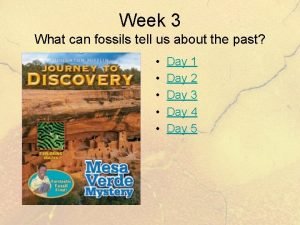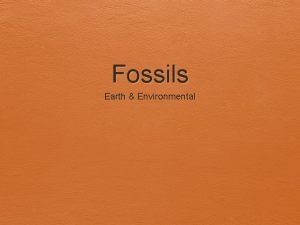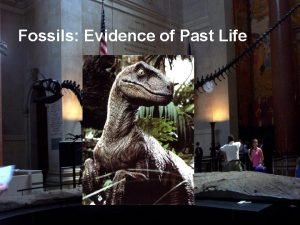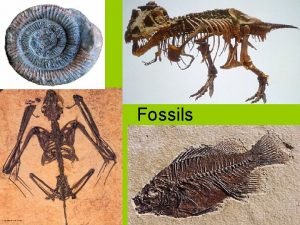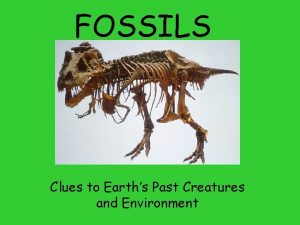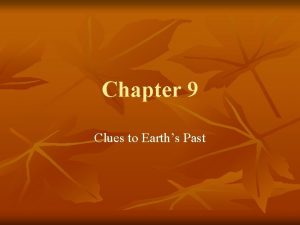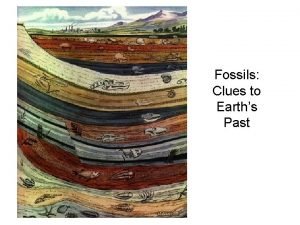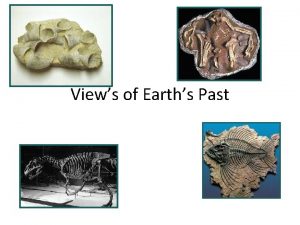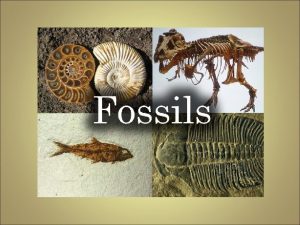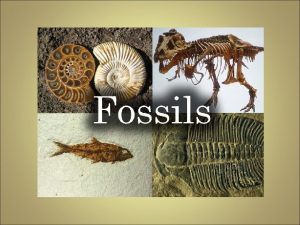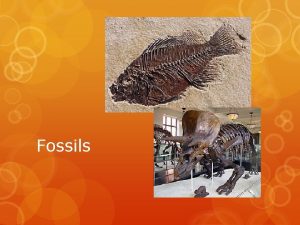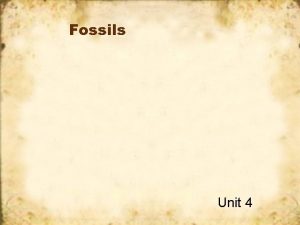Clues to Earths Past Fossils Remains imprints or




















- Slides: 20

Clues to Earth’s Past

Fossils �Remains, imprints, or traces of prehistoric organism.

Permineralized remains �Fossils where the spaces inside are filled with minerals

Carbon Film �A flim of carbon can form around an organism creating a silhouette

Mold-Cast �Mold- imprint left after hard parts of organism decay �Cast- a copy of organism made from the mold

Trace Fossils �Fossils that are evidence of organisms activity (not organism itself) �Such as: � Tracks/footprints � Burrows � Trails

Index Fossils �Abundant, widespread organisms that existed for a SHORT period of time.

Principle of Superposition �In undisturbed layers of rock, the oldest rocks are found at the bottom, with the rocks becoming younger towards the top.

Relative Age �Relative age is how old a rock or fossil is in COMPARISON to the ages of other things.

Igneous Intrusion �when an igneous intrusion cuts across a formation of rock, it can be determined that the igneous intrusion is younger than the rock it’s cutting through.

Unconformities �Unconformities are when layers of rock are missing �Unconformities develop when running water or glaciers remove rock layers

Angular �When rock layers are tilted and younger sediment layers are deposited horizontally on top of the eroded and tilted layers

Disconformity �When a layer of horizontal rock is exposed and eroded before younger rocks form over it

Nonconformity �When sedimentary rock forms over eroded metamorphic or igneous rock

When the layers are too disturbed: �The same rock layers can be found in different locations; FOSSILS must be used to prove that the layers match up

Absolute Dating �Calculating the absolute age of a rock by measuring the amounts of materials in a rock and knowing the material’s half life.

Half-Life: Time it takes for half of the atoms in an isotope to decay

Radioactive Decay �Breaking down of an atom into a proton and an electron.

Radiometric Dating �Uses the properties of atoms in rocks and other object to determine their ages.

Uniformitarianism �Principle that Earth’s processes occurring today are similar to those that occurred in the past.
 Remains, imprints or traces of once-living organisms
Remains, imprints or traces of once-living organisms All types of fossils
All types of fossils Imprints 12
Imprints 12 Boda boda types of clues
Boda boda types of clues What do fossils tell us about the past
What do fossils tell us about the past What do fossils tell us about the past
What do fossils tell us about the past Why would humans be a good index fossil
Why would humans be a good index fossil Fossils evidence of past life
Fossils evidence of past life Whats the name of earths moon
Whats the name of earths moon Earths early atmosphere contained
Earths early atmosphere contained Spring earth tilt
Spring earth tilt Earths layers foldable
Earths layers foldable Arch of constantine frieze
Arch of constantine frieze Brown earths
Brown earths What is the most abundant element on earth
What is the most abundant element on earth Earths mantle
Earths mantle Lithosphere
Lithosphere Layers of the atmosphere definitions
Layers of the atmosphere definitions Earths roation
Earths roation What does earths tilt do
What does earths tilt do Study of earth's physical features
Study of earth's physical features




